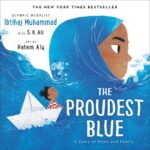The Proudest Blue by Ibtihaj Muhammad and S.K. Ali.

Published by Little, Brown Books on September 10, 2019
Key Words: Hijab, Siblings, Strength, Change, Family, Bullying
Summary: Written by Ibtihaj Muhammad, an Olympic medal winner and one of the first to compete with a hijab for the United States team. The story describes Ibtihaj’s two sisters, Asiya and Faizah’s journey, written from the younger sisters’ Faizah’s perspective. Faizah is watching as her sister Asiya is on her hijab journey and attends school with the Hijab on for the first time. When looking at her sister, Faizah compares her to a princess, yet when they get to school, she does not understand why people are mistreating and making fun of her sister. She continues to defend her sister, Asiya, throughout the story, yet her sister does not allow other people’s words to affect her. In the end, Faizah still looks up to her and hopes to be like her.
Book lesson: Through reading about Faizah and learning how she defends her older sister Asiya when she wears the hijabfor the first time, readers can gain insight into the significance of familial support and the importance of being respectful and learning about others’ religions.
Censorship: Not banned or censored
Highlights: The best part was the little sections in the book, where, after someone commented on Asiya Hijab, Faizah would share her thoughts on their remarks. For example, Faizah hears boys pointing and laughing at her sister, and she questions why they are doing that. She then states that “Asiya hijab isn’t a laugh. Asiya hijab is like the ocean waving to the sky. It’s always there, strong and friendly,” showing that the children bullying Asiya may not understand what the hijab truly is and are acting out of misconceptions.
Children’s identity: The Proudest Blue impacts children’s sense of self by highlighting the harms of bullying and judging others without understanding or learning about different religions and cultures. While it does not directly show how Asiya is affected by these comments or events, it depicts how her younger sister Faizah is influenced, illustrating the ripple effect of harm these actions can cause. As a result, children can develop a better understanding of the effects of their behavior and learn about different religions and practices, like wearing the hijab. Additionally, for kids who may have experienced similar situations, this book offers comfort by showing they are not alone and encourages them to stay strong.
Sense of how others perceive us: For Faizah, how others see her sister is something she does not fully understand because she sees the hijab as beautiful. Since Asiya does not show she’s affected by the comments or situations, Faizah is not afraid of how others might perceive them and instead feels confident, wanting to be like her sister. This resilience is demonstrated at the end when Faizah draws a picture of her and her sister wearing hijabs and shows it to her mom.
Sense of family: Family is deeply valued throughout the story and is evident through the relationship between Asiya and Faizah. Faizah looks up to her younger sister and defends her in every situation, showing how much she cares. Their mutual support boosts their confidence and positively influences their daily lives.
Sense of belonging/community: Although Asiya may have felt like she did not fully belong because of hurtful comments, this is not explicitly mentioned in the book. It appears she always had a group of friends she could rely on and her little sister, Faizah, for support. For Faizah, her experience is similar, but she also feels more hurt by people around her for not understanding why her sister wears the hijab, which could impact her sense of community at school.





